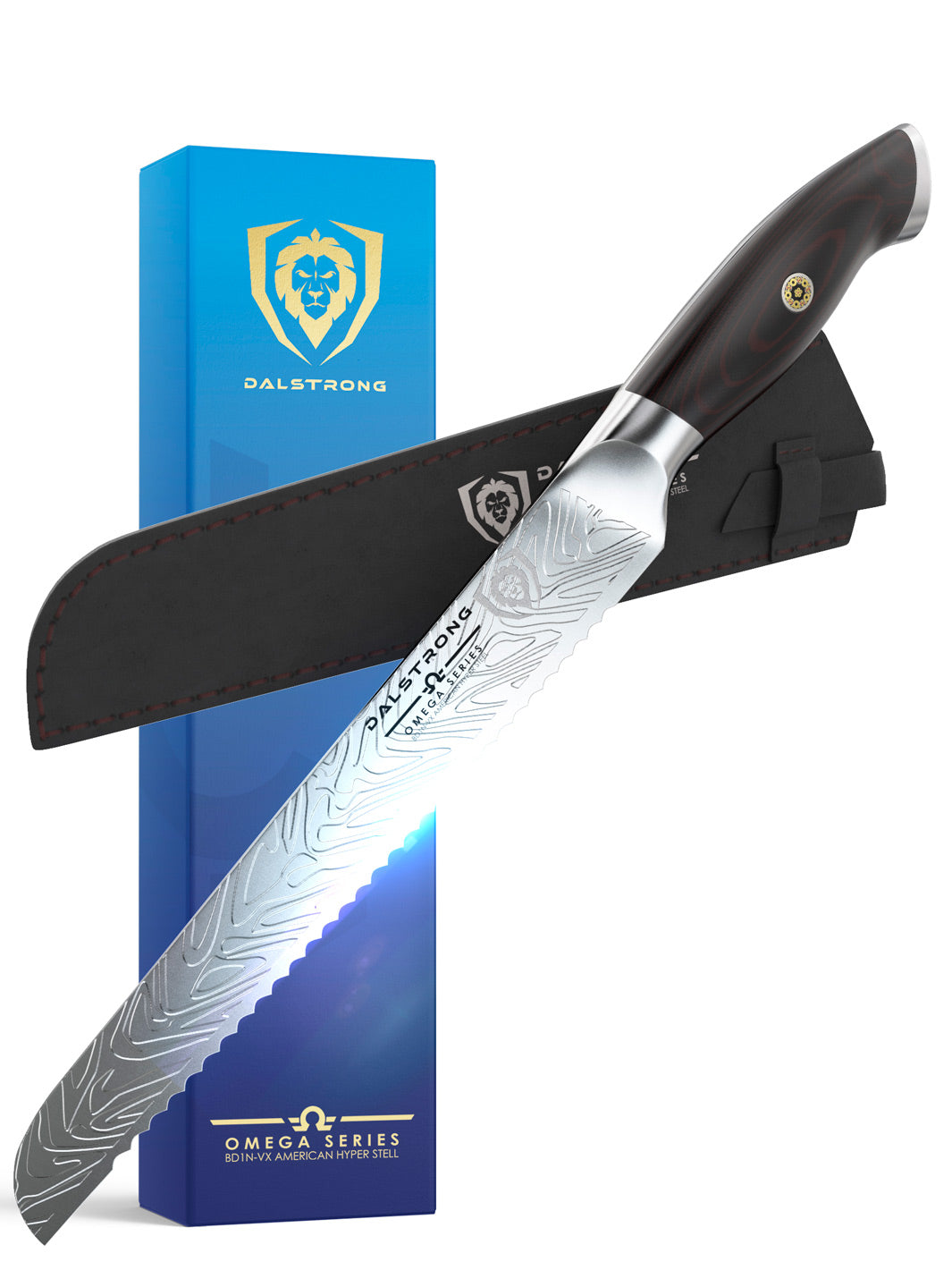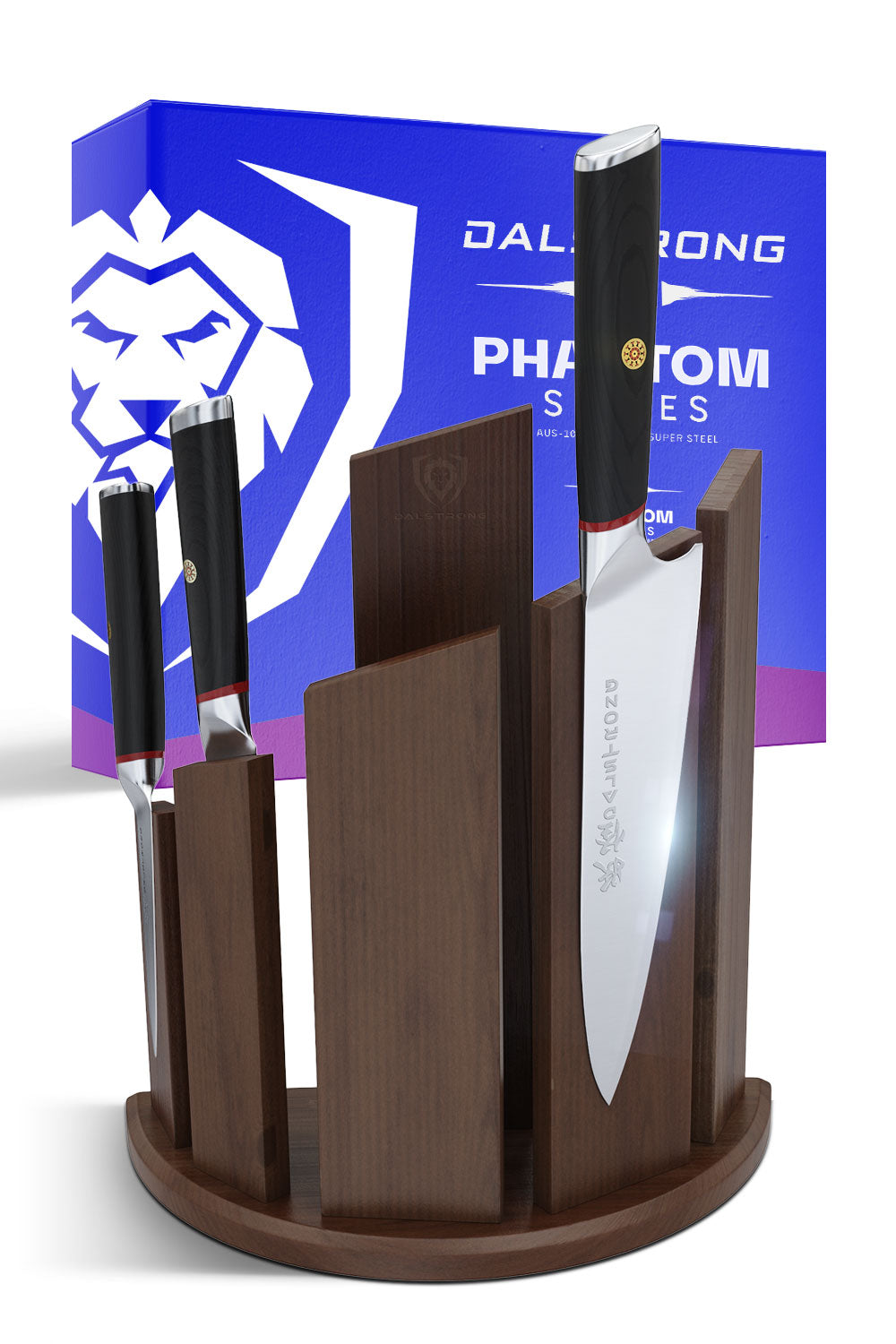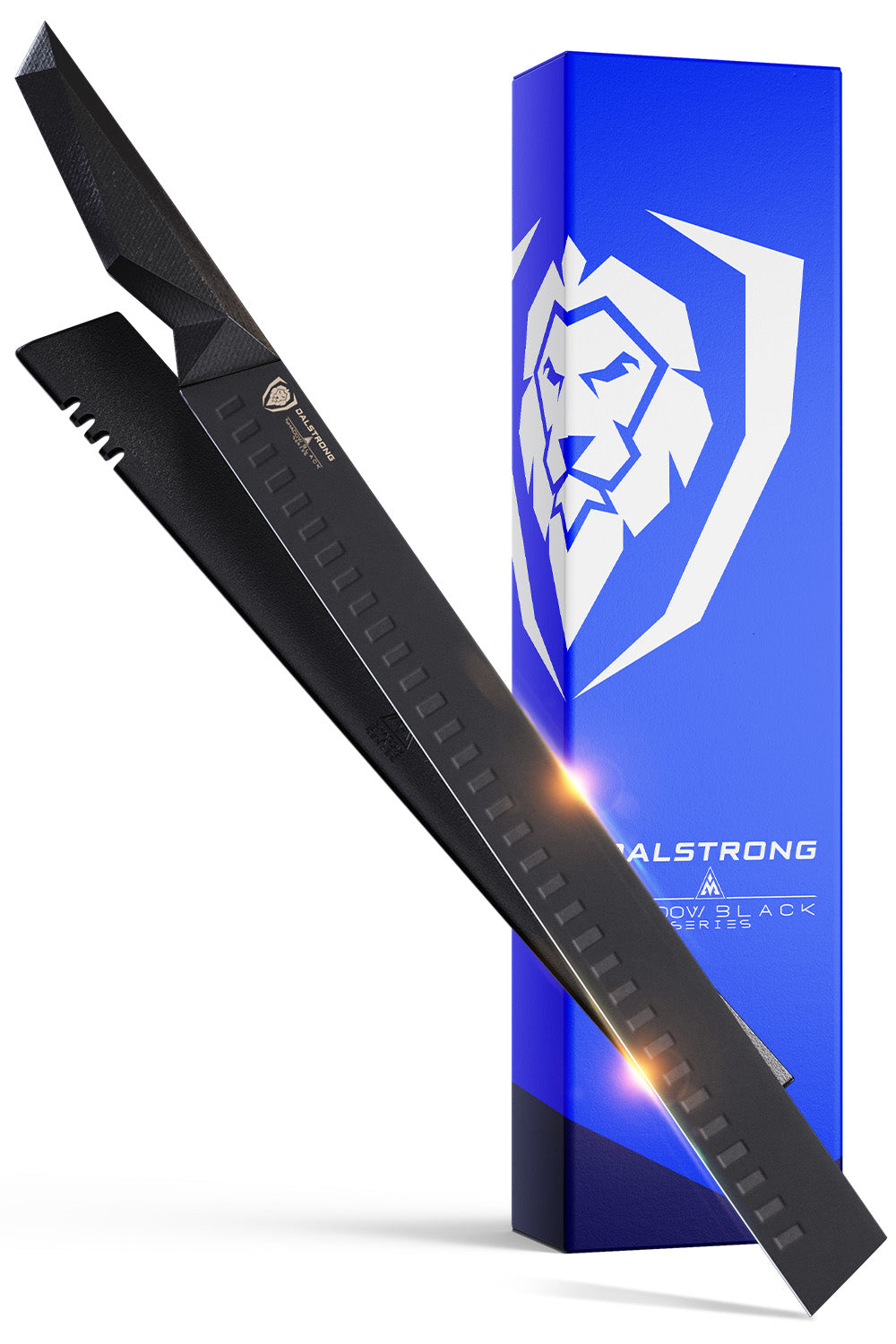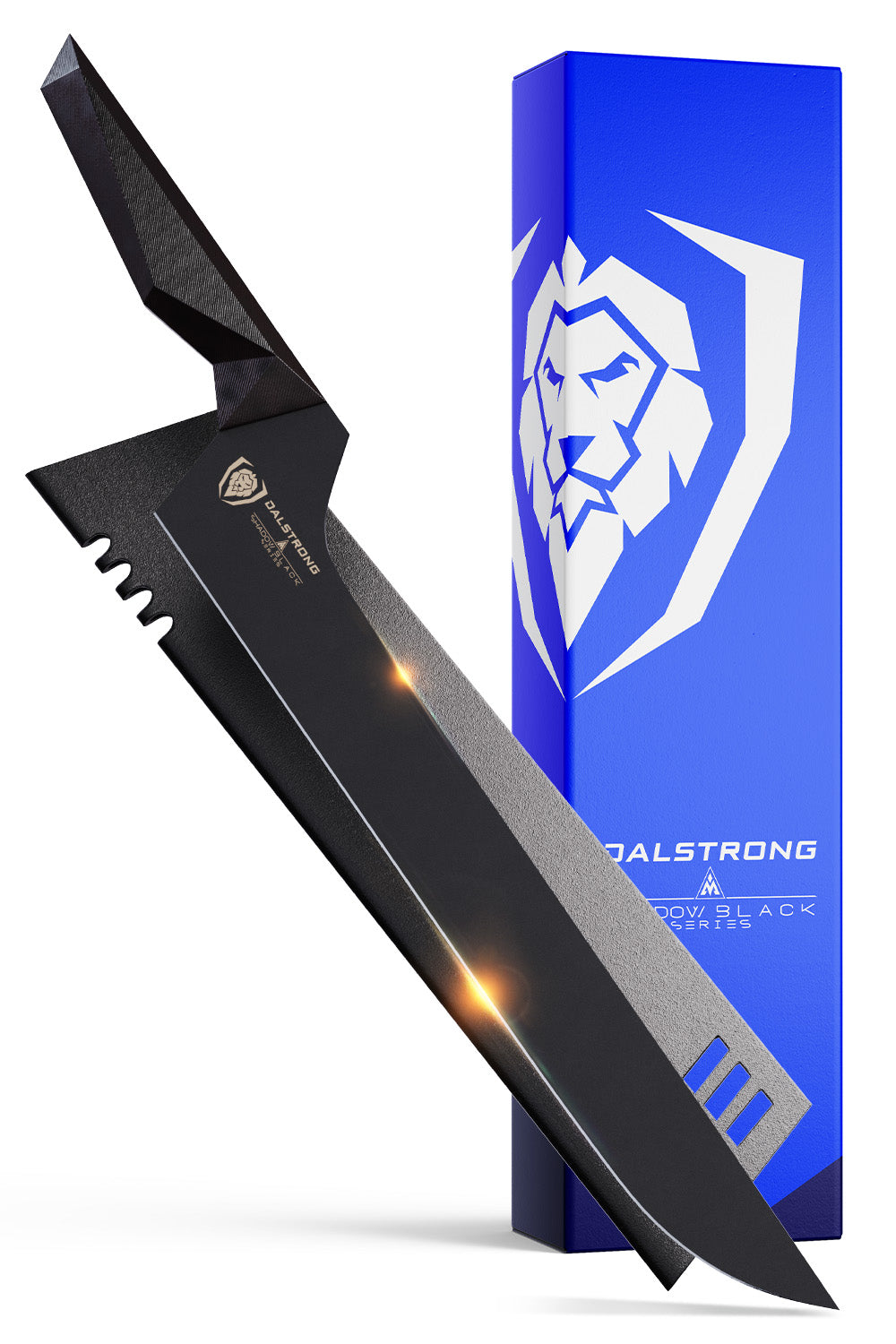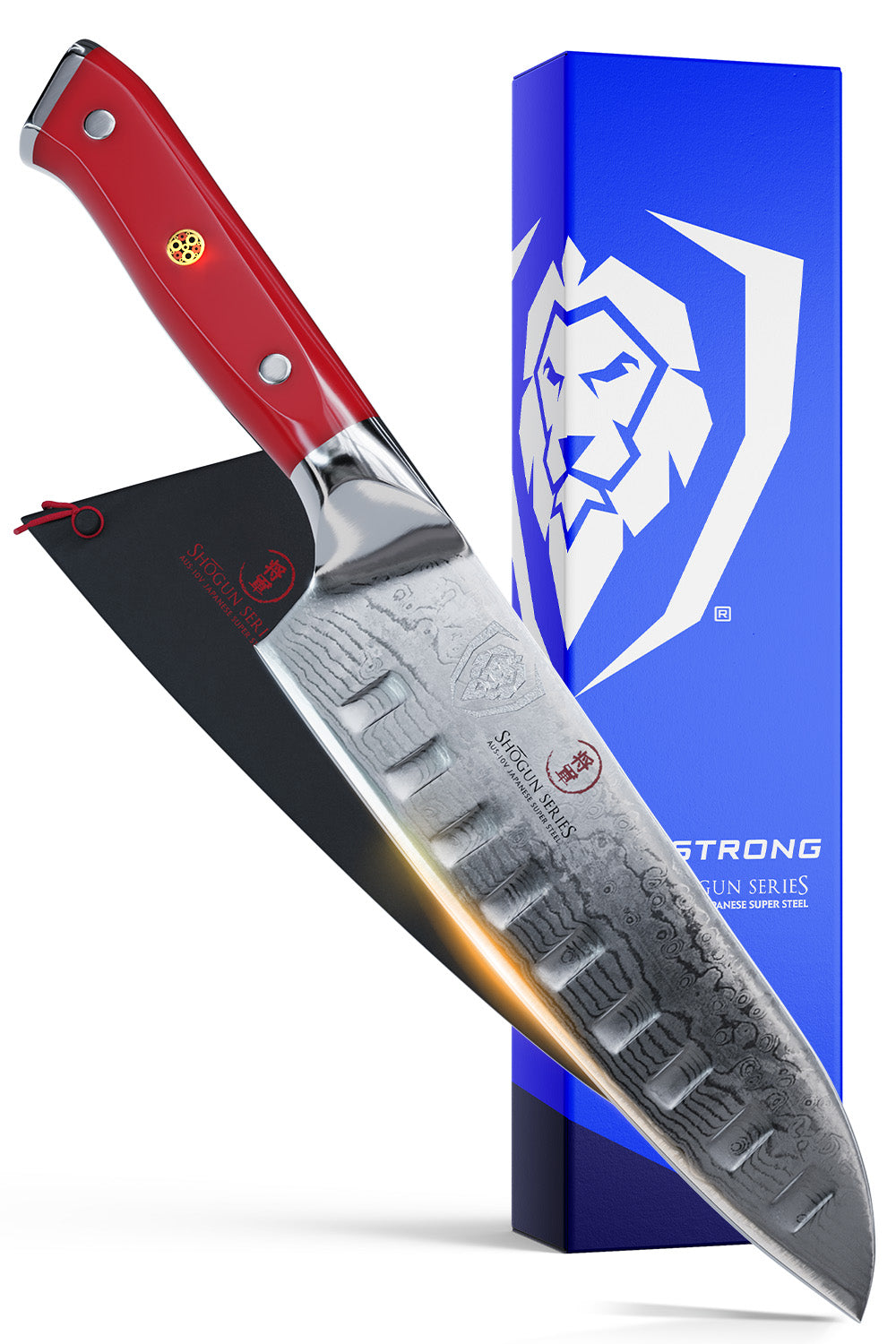 Serrated Offset Bread & Deli Knife 8" | Gladiator Series
Serrated Offset Bread & Deli Knife 8" | Gladiator Series
What Is An Offset Slicer And Why Every Chef Should Own One
An offset slicer is a slicing knife where the blade is lower than the handle, creating a fully ergonomic L-shape.
This type of blade works well on bread, smoked meats, vegetables, and fruit. The offset handle allows a full cut before your hand hits the cutting surface while reducing wrist fatigue.
In this article, we will go into more detail on why an offset slicer is an underrated knife in your kitchen and why every chef should think about getting one.

1. What's Special About An Offset Slicer?
With an offset knife, the blade is lower than the handle by an inch or more, creating an L-shape which is its one distinctive characteristic.
Other than that; offset knives vary in their presentation. They can have serrated or straight-edged blades; they can have a rounded or a pointed tip; the blade and the handle can be made of a variety of materials.
Offset slicers can also have a scalloped edge. These Scalloped offset slicers have a slightly indented blade, however, scalloped offset slicers and normal offset slicers have little difference when it comes to slicing.
An offset slicer is an offset knife that has been designed to slice and cut through several foods with efficiency and ease.
There are several reasons for a slicer to have an offset design. One is safety: the cook's knuckles are always higher than the knife edge and away from the cutting board. Another is comfort. The knife becomes easier to hold and easier to use, and the grip is simply more comfortable because the knife is 100% ergonomic.
Also, less pressure and effort are needed for slicing hard, crusty or layered food (less strain on your wrists). At the same time, you feel like you have greater control.
2. The Case Of The Deli Knife
Believe it or not, cleanly slicing a sandwich can be a tough mission. You need to get it right with the crust, the softer crumb, the watery tomato, and the delicate lettuce; just to name a few of the possible challenges.
The bread could crumble, the ingredients might fall out, and if the tool is not the right one, you may find yourself trying several times and in different ways because the first cut won’t do it. Chances are you end up breaking something you weren’t supposed to or, best case scenario, not cutting at all and dedicating more time to a task that should be simple.
This is why the sandwich knife exists, also known among professionals as the deli knife. This knife type is the model that takes the most advantage of an offset handle and all the benefits that come with it (which are explained in detail in the next point).
In my opinion, this is one of the most irreplaceable items in the kitchen. More than a few times I ruined a club sandwich by using a standard knife when I was supposed to be using this.
The deli knife is arguably the best example of an offset slicer.
3. Benefits Of Using An Offset Slicer
An offset slicer can become the most useful utility knife in your arsenal. Chefs who work at a restaurant and need to slice things continuously throughout the day can confirm this.
The non-traditional shape of offset knives offers many advantages, most of which you need to experience for yourself. But just to give you an idea of why they are often included in sets of professional cutlery:
- You have more leverage and less pressure is needed to cut through different textures.
- Your knuckles don't hit the cutting board. You will have more room to maneuver with your hands without touching the cutting surface (based on my personal experience, it's great for large hands.)
- The offset design is kind of empowering: it gives greater feeling of control, balance, and accuracy; especially with the addition of non-slip handles.
- This design allows for cleaner, thinner slices.
- This design is highly ergonomic, which means it is easier and more comfortable to use. You can comfortably use this type of knife for a longer period.
- Less strain on the wrist, which is great for those who have carpal tunnel.
- An offset bread knife with a serrated edge cuts easily through crispy and delicate bread, without crushing or breaking the soft interior. They are ideal for bakeries, cafeterias, or restaurants because they can cut sandwiches and side dishes without crumbling, smashing, or tearing anything apart.
- Straight edge offset slicers are perfect for making very clean, sharp cuts and slicing and carving ham, roasts, brisket, large fruits and vegetables, bread, and cakes.
4. What Can You Cut With An Offset Slicer?
For easier slicing work, use a serrated offset slicer with these foods:
- Bread (especially those really crusty ones)
- Pizza
- Roasted and BBQ meats
- Burgers, sandwiches, and bagels
- Tomatoes
- Peppers
- Quiches, pies and cakes
- Poultry
- Pineapples
- Cucumbers
- Watermelon
5. Serrated Offset Slicer Vs. Straight Edge Slicer
In the world of offset knives; you can find both serrated and straight edge slicer options.
Serrated offset slicer
The ridges in a serrated offset knife are great for meat, bread, tomatoes, cucumbers, and peppers; just to name a few examples. The serrated edge (which pretty much acts like small human teeth) first grips and pierces the outer layer; and then slices the inner layers of food.
You use them by applying pressure with a sawing motion. This process is easier with an offset model than with a traditional serrated knife.
The offset serrated knife par excellence is the deli knife or sandwich knife.
Straight edge offset slicer
This offset knife features the traditional blade with a straight edge (no “teeth). Great for slicing, dicing, mincing, chopping… and most of the kitchen daily tasks.
The advantage of a straight edge knife is that it gives you a very smooth cut, as opposed to serrated knives which tear food, so to speak. They are better suited for delicate foods in which you need clean, sharp cuts; like sushi. They are also easier to sharpen.
A straight edge offset slicer is a must-have; even though their uses do have a few exceptions in which you will need a serrated blade, like tomatoes or kiwi.
Here’s an overview of the differences between a serrated offset knife and a straight edge offset knife:
|
Serrated offset slicer |
Straight edge offset slicer |
|
|
Knife shape |
The edge is designed with ridges like a saw. |
The edge is continuous, plain, and smooth. |
|
Best for |
Foods with a crusty outside and a softer interior and foods with different textures or layers. |
Delicate foods, soft foods, and most day to day cutting tasks. |
|
Type of maneuver |
Back and forth, using a sawing motion. |
Strong, steady downward pressure. |
|
Type of cut |
First grips the surface of the food, then slices. |
Clean and precise cuts. |
|
Ease of sharpening |
Not as easy to sharpen. |
Significantly easier to sharpen. |
|
Knife example |
Deli knife or sandwich knife. |
Offset carving knife, offset fillet knife. |
6. Best Offset Slicers
Serrated Offset Knives
1. Serrated Offset Knife 8" | Shogun Series
66 layers of Damascus steel, sharpened under the 3-step Honbazuke method; prove that this is not just another scalloped knife. A combination of power and delicacy makes this blade perfect for hard foods and soft foods alike.
PROS:
- The L-shaped blade reduces strain on the wrist and hands.
- You will cut through the crust and flesh of tomatoes, meats, bread, and fruits with the toughest skin like pineapples, watermelons, gourds, etc. without tearing them.
- The offset handle will give your knuckles a break.
- Incredible sharpness at an 8-12°degree angle per side.
- The design is not just functional, but beautiful: The blade comes with the Tsunami Rose pattern and the handle features an intricate copper mosaic.
CONS:
- Sharpening a serrated knife yourself will usually require more know-how than straight blades.
- The price is expected for this quality, but some would sacrifice a few qualities to save money.
2. Serrated Offset Bread & Deli Knife 8" | Gladiator Series
Sandwich lover? this way, please. One of offset knives’ main advantages is that they don’t require too much pressure to cut through foods with several layers, like sandwiches. That’s why deli knives (also known as sandwich knives) are usually offset.
PROS:
- Cuts through all types of bread and sandwiches without destroying anything.
- A fully serrated knife (scalloped) could tear apart the softer ingredients; a straight edge knife couldn’t slice through the crust. This slightly serrated blade is the perfect middle ground.
- Ergonomic and ambidextrous.
- High quality at an affordable price.
- Easy to clean.
CONS:
- 8” is a standard size for a bread knife, but you can get a smaller or a larger serrated knife to your taste. As long as you're comfortable while cutting your sandwich!
- We’ve already explained the advantages of an offset knife; but if you already own a serrated model and you are particularly skillful with it, you may not need a deli knife at all.
Straight Edge Offset Knives
1. Slicing & Carving Knife 12" | Gladiator Series

The offset shape is a nice touch for this otherwise classic slicer. Just as the previous knives we recommended, your fingers and knuckles will be safe, but with a 12” blade it is clear this is not a utility knife: you will work on those large cuts of meat like a real Roman Gladiator.
PROS:
- Cuts through meat, bread, and fruits with the agility of a sword.
- The high carbon blade has been hand polished with a satin finish.
- The G-12 handle will last a lifetime.
- Top performance, yet low maintenance.
- NSF Certified.
- It comes with a “PerfectFit” sheath.
CONS:
- If you put it up to the task, it will do the job, but It doesn’t guarantee the “dual power” that serrated knives have for the hard + soft combination in food.
- If you’re not into the whole offset thing, you can get a similar slicing or breaking knife from this same series without the L-shape.
2. Offset Slicing Carving Knife 12" | Shogun Series ELITE
Holding this slicer in your hands is already a pleasant experience. And the blade is not that far away from a Samurai sword: razor-sharp Japanese steel, artistically engraved and carefully crafted over 60 days.
PROS:
- Beautiful, empowering knife with the Shogun Series’ distinctive artwork in motion.
- Not only sharp like a scalpel, but it will also maintain that sharpness for longer.
- It’s designed so food won’t stick to the blade.
- Cryogenic tempering makes the steel strong and flexible.
CONS:
- This is an elite knife, and that will reflect in the price as well.
7. Frequently Asked Questions About Offset Slicers
Is an offset knife better for cutting bread?
You can cut bread with a regular serrated knife; but we highly recommend an offset knife for this task, especially if you do it often.
What is the difference between a deli knife and a sandwich knife?
Both terms are often used interchangeably. A deli knife is also known as a sandwich knife. However, some argue that a sandwich knife is shorter and can’t cover the same range of tasks as a deli knife.
What is a micro-serrated knife?
A micro-serrated knife is a multi-purpose knife with tiny serrations on the blade. These serrations are not as obvious as regular saw-like serrated knives and you only notice them if you look close. They are perfect for cutting tomatoes.
Food & travel writer based in Buenos Aires. Superpowers include relentless curiosity and high tolerance to spicy foods.



